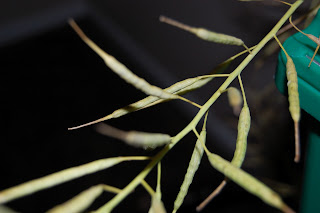Squash, Melons & Peas
Some plants make it super easy to know how to save their seed. Cantaloupe, watermelon, zucchini, peas and most squashes are pretty straight forward when it comes to seed saving. All you have to do is open them up scoop out the seeds, wash them off and dry them out on a paper plate. The picture above shows the peas separated from their pods.
Tomatoes
Others are a bit trickier. Tomatoes come to mind. In order to save tomato seeds you will need to use the following method. Scoop your seeds out and place them in a mason jar with enough water to cover them up well. Place a coffee filter over the top of the jar and secure it with a rubber band. You will need to leave this set to ferment over a few days. This process allows the mucousy covering around the seed to rot away so there is nothing to impede the growth of the seed the following year.
After the jar has set out for a few days you will need to dump the contents into a fine mesh strainer and rinse your seeds to remove all of the pulpy material. Once the seeds are well cleaned place them on a coffee filter on a paper plate to let them dry out before you store them for the winter.
Lettuce & Cole Crops
Most lettuces, if allowed to bolt will produce flowers which when allowed to dry will create small seed heads that can be collected and the seeds freed by lightly rolling them between your fingers over a piece of paper. The seeds will drop onto the paper and you can separate them from the rest of the flower to store over the winter. This year I got a bit lazy and instead of pulling things out of the raised beds when the spring season was over I left them in the beds, let them go to seed and put the seeds right back in the ground for the fall season.
Cole crops are even easier! When they are left to go to seed they will produce seed pods that can be simply plucked from the plant, cracked open and the seeds inside can be collected and saved. The picture below are the seeds pods from our Chinese Cabbage plant. All cole crops will have similar looking pods.
Here are a few tips to remember when starting your personal seed banks.
- Make sure the seeds you save are heirloom seeds so that you can be sure you will be getting the same plants next year.
- Label everything! Including the plates, coffee filters and jars you are using to dry your seeds out. Include the type of vegetable, name, year and if you know where it came from originally include that too.
- There are many templates out there for seed packets so print some off or create your own. Use your imagination to decorate them and include the kids!
- Talk to your neighbors and friends and let them know what kind of seeds you have and see what seeds they have that they might be willing to trade so that you can add some variety to your garden next year.
- If possible space different varieties of the same type of vegetable as far apart as possible in order to avoid cross pollination which can create plants that might not be identical to their parent plants.
- Always gather the best looking seeds from the best vegetables from your crops in order to ensure that you are propagating strong healthy new plants.





No comments:
Post a Comment